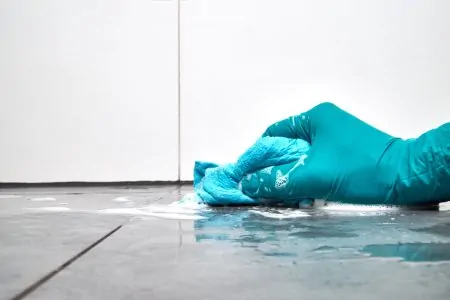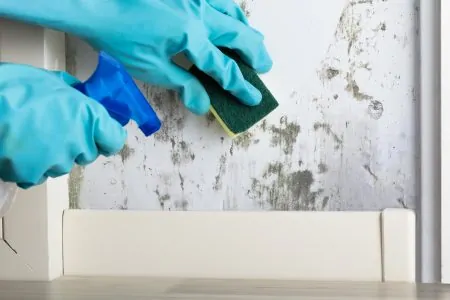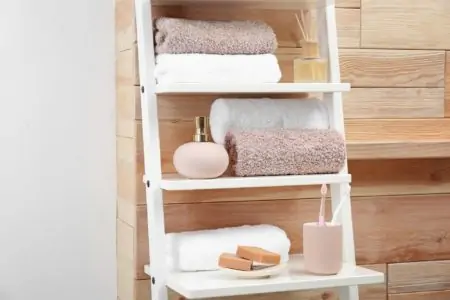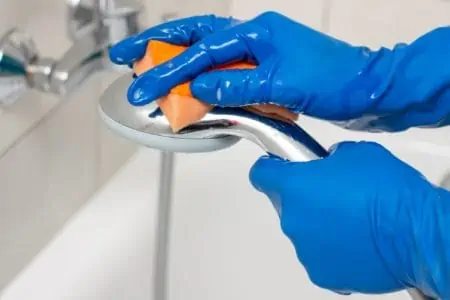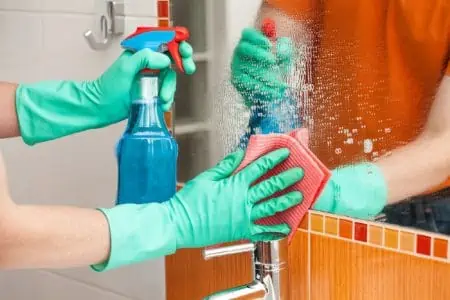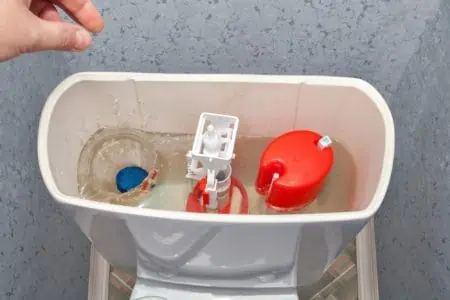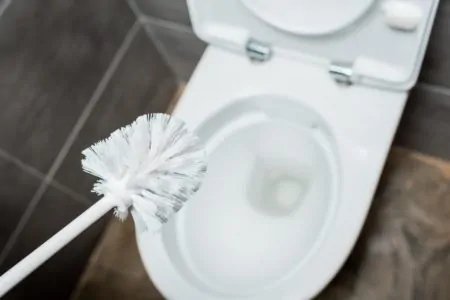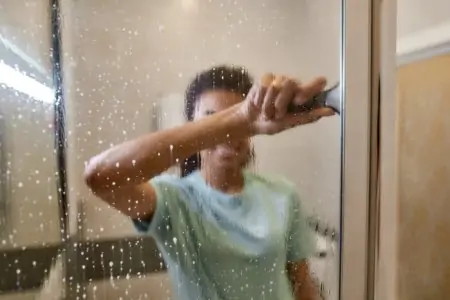Your shower floor can get grimy from all the bacteria, soaps, and shampoos that you expose it to daily.
How often should you clean your shower floor? And how do you do it?
This area requires a lot more attention than most of us give. But it’s time to make a change. We’ll show you the best method for how to clean shower floors so that this bathroom corner feels more like a luxury than a misery.
Key Takeaways
- Use non-abrasive cleaners and tools for fiberglass shower floors, such as Dawn Dishwashing Soap or Lysol, and avoid ammonia or steel wool.
- Clean your shower floor weekly by scrubbing it with a non-abrasive cleaner, then rinsing and drying it.
- Remove tough stains with vinegar, hydrogen peroxide, baking soda, bleach, or lemon juice, depending on the type of stain.
- Maintain a clean shower by rinsing the floor after each use, cleaning it weekly, removing stains promptly, and restoring the surface as needed.
Before we get started, we must discuss which cleaners and tools are effective and which can be damaging. Most shower floors are fiberglass, similar to a bathtub. This surface calls for a non-abrasive soap and tool.
- Mild cleaner: Always opt for a non-abrasive cleaner for the shower floor. Something like Dawn Dishwashing Soap or Lysol is excellent at cutting through grease and grime.
- Avoid ammonia: Ammonia is an alkaline and can damage fiberglass surfaces.
- Use non-abrasive tools: Tools like a two-sided sponge, soft brush, or cloth are the best options for cleaning the shower.
- Avoid steel wool: Steel wool or scrapers will scratch and damage the finish of the shower floor.
Cleaning the Shower Floor
Let’s start with the best method for cleaning the shower floor. This is the part of the shower that accumulates the most nastiness. You should aim to do this weekly, but it will be even more beneficial if you do it daily.
- Time: 5-10 minutes
- Difficulty: Easy
1. Scrub
Start by applying your non-abrasive cleaner to the shower floor using a sponge or cloth. Gently scrub the cleaner into the corners and around the center. Don’t forget the area around the drain — a lot of soap scum and grime will settle here.
If your shower floor is textured, you may need to scrub a little more to get all the grime away.
2. Rinse and Dry
After scrubbing the entire floor, rinse with clean water. Use the showerhead and direct the water into the corners to get all the cleaning solution out. Once you’re done, wipe the floor using a cloth.
How to Remove Tough Stains
Sometimes the quick-cleaning method doesn’t cut through all the stains. For tackling stubborn spots in your shower, there are a few hacks you can try.
Vinegar
Removing soap scum and watermarks is often tricky and can make your shower look filthy. If you have some white vinegar in the pantry, you can easily use it to cut through the grime. Because of the acid in vinegar, it is superb at removing grease and oils.
Pour a generous amount of vinegar over the stains and allow it to sit for a couple of minutes. Then use a sponge or brush to scrub the marks off. Rinse once you’re pleased with the results.
Hydrogen Peroxide
You can use hydrogen peroxide, which is a mild bleach, to restore the white surface and eliminate dark stains. However, it’s not a one-minute fix, so make sure no one needs the shower until the next day.
Place a white cloth over the stain and soak it generously in hydrogen peroxide. Allow the cloth to stay on the mark overnight, and then rinse off and dry with a towel (1).
Baking Soda
If you’re not dealing with hard watermarks but still see stains, a baking soda paste could work. Baking soda effectively cleans stains like soap scum.
Make a paste with equal amounts of baking soda and water. Cover the stains and allow it an hour or two to work. Scrub using a sponge or brush until the marks give in. Then rinse with water and dry the area (2).
If you want to make an extra powerful paste, use white vinegar instead of water. Mix equal parts to create a paste and apply it to the stains. Allow it to sit for a couple of minutes, then scrub and rinse.
Remove Mildew With Bleach
Mildew is, unfortunately, commonly found in and around the shower due to the moist environment. Mildew and mold can cause some frustrating stains that make your shower floor look old and dirty. It can also be a significant health concern for you and your family (3).
For this method, you’ll need chlorine bleach and a non-abrasive brush. Start by applying a small amount of bleach to the stain — be careful not to splatter as you pour. Leave it to soak for a couple of minutes and then scrub the area with a brush — rinse the floor thoroughly once you’re done.
Stay Safe
Lemon Juice
If you have recently had a leak in your shower, there might be some rust stains on the floor. This can seem like a challenge, but it’s relatively easy to remove.
For rust stains, we like to use fresh lemon juice. Pour the juice directly onto the stain, using enough to cover it. Leave the acid to work its magic for a couple of hours.
Rinse the area once the time is up and scrub using a sponge. Let the water run for a while to neutralize the acid in the juice. If you don’t have lemon juice, you can also use white vinegar.
For extra tough stains, create a paste of lemon juice and baking soda. Spread it generously over the stains and leave it for up to three hours. Scrub vigorously using a sponge to dislodge the rust.
Maintenance Tips
To ensure you have a clean shower ready at all times, follow these tips:
- Rinse the floor: After a shower, rinse the floor using the showerhead. Doing this will remove soap and other grime before it gets a chance to stain.
- Clean the shower weekly: Cleaning the shower once a week will help to prevent stains and soap residue. Regular cleaning will also reduce the need for strong cleaning products.
- Remove stains: When you spot a stain or mildew, remove it immediately to prevent it from settling.
- Restore the surface: If your shower floor has taken a beating and looks dingy, you can restore it. By using an automobile polish, you can eliminate scratches and dull spots.
FAQs
Keeping the Shower Fresh
Having a clean shower to wash the day’s stress away is essential. It can be very unpleasant to shower on a grimy floor, and you’re often left feeling dirtier than before.
Cleaning the shower floor isn’t difficult if you do it regularly. However, leaving the stains and soap scum to build up, you will need more elbow grease.
With our favorite cleaning methods, your shower will feel oh so spotless!
